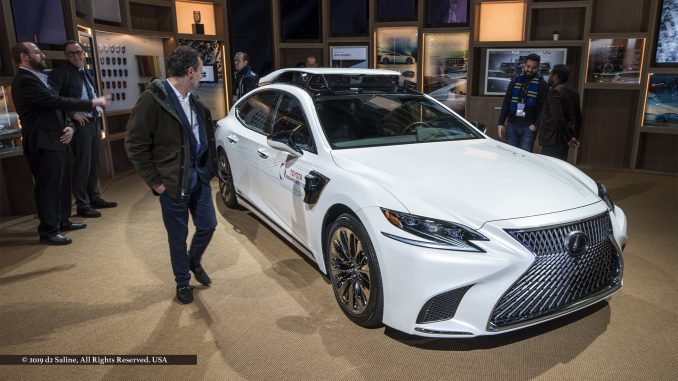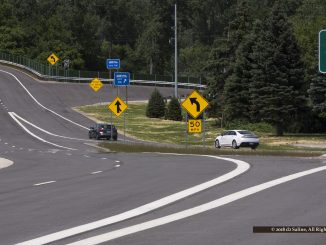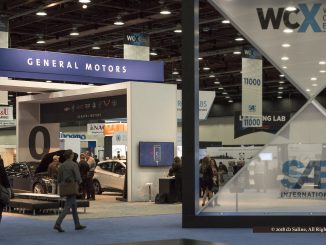
In many ways, the North American International Auto Show (NAIAS) presentation of a Lexus 500h with automated driving modifications was symbolic of desired positioning of the vehicle itself. To be sure, its dedicated space was singularly carved out at the rear of the massive Lexus main show floor presence. At the same time, simply another part of the greater product line, perceptually matter-of-fact. [1,2]
Dubbed the “P4” in recognition of its place as fourth-generation platform of its type, transformation from consumer sedan to Platform 4 took place only 6½ miles from Saline four-corners, Toyota Motor North America, Research and Development on Platt Road. After making its debut at the Consumer Electronics Show (CES) in Las Vegas earlier this month, Detroit is the last stop for this car before returning home to York Township. [3-7]
During a scheduled meeting at Cobo Center with Saline Journal this morning, lead members of the P4 team discussed its importance and place on the road.
“CES is more broadly tech-focused,” began Rick Bourgoise, Communications Manager for Toyota Research Institute. “There, we were talking about future advancements, five, ten, fifteen years out. NAIAS is here-and-now, what will be for sale within a year or so.”
As a result, CES was oriented toward the “Chauffeur” version of P4, NAIAS anticipates more discussion of “Guardian.” In a written overview released on January 4, Ryan Eustice, Senior Vice President, TRI, delineated their two-track automated driving system development as follows.
Our Chauffeur development is focused on full autonomy, where the human is essentially removed from the driving equation, either completely in all environments, or within a restricted driving domain …. Guardian, on the other hand, is being designed to amplify human performance behind the wheel, not replace it.
Expanding on this today, he told us that “There is a lot of focus right now on ‘perception.’ How does the vehicle sense the world? Technology is good at that.
Now think about approaching an intersection with a traffic light. The light is green, and humans know what that means; ‘go.’ Machines also know the same thing — as far as it goes. But what happens if a police officer steps out into the street and holds his hand up? Machines still have trouble with that distinction. Now say you’re driving on Stadium and a UofM football game has just let out. You are anticipating interactions with police, maybe even tuned to completely disregard the [traffic] lights for a while.
But what if the person who puts his hand up is not in uniform, a kid? What if he’s not in the street, not in your way, and you know he isn’t serious? What if he =is?
More than that the differentiated marketplace here of NAIAS, Mr Eustice believes that Toyota Research Institute has a competitive advantage with its Guardian track. Although kindred to the Chauffeur here on display in terms of sensors and computing, Guardian cars are fitted with two steering wheels. The one in standard driver position is used for traditional technician backup, the passenger-side wheel is for simulated driver error.
While Rick Bourgoise was candid in telling us that fully autonomous vehicles will “probably [arrive] a lot further out than people imagine,” Ryan Eustice assured us that the important next step to watch is in the vehicle-as-collaborator space, “coming very soon.” [8,9]
The roof-mounted sensor array is part and parcel of this. In addition to capability of “seeing” out to a distance of 250 meters in all directions, they provide thermal imaging. This allows detection of body heat from humans and animals, and other vehicles — even in total darkness. Sitting atop the passenger compartment, it is also quite pronounced.
TRI Vehicle Integration Engineer Velin Dimitrov brought this back to the fact that P4 is a modified, off-the-floor Lexus 500h, as opposed to a design where the sensor array would have been something to be incorporated from earliest concept. “I can assure you that the car you’ll buy won’t look like this,” he said with the look of a man who’d already given this a great deal of thought.
At the same time, it’s good that these features stand out for the time being. We want people to see this is an autonomous car — to know that they’re out there.
At the close of the North American International Auto Show, this TRI P4 will return to Washtenaw County and begin the proving work for which it was originally intended. And an undisclosed, “low volume” production of Chauffeur and Guardian track variants will start to be completed this spring, in York Township Michigan. Before long, commonplace sightings in neighboring Saline should hardly give us cause for notice.
References
- North American International Auto Show (home page).
- “The 2019 LS” Lexus.
- “Toyota Research Institute Rolls-out P4 Automated Driving Test Vehicle at CES” (January 4, 2019) Toyota.
- “Toyota Motor North America, Research and Development (TMNA R&D),” Toyota.
- “Toyota Motor North America, Research and Development | Toyota” Toyota USA (November 30, 2018) YouTube.
- CES: Consumer Technology Association (home page).
- York Township (home page).
- “Self-driving cars: A level-by-level explainer of autonomous vehicles” Kyle Hyatt and Chris Paukert (March 29, 2018) c|net.
- “Path to Autonomy: Self-Driving Car Levels 0 to 5 Explained – Just what does ‘Level 5 autonomous car’ mean?” (October 2017) Car and Driver.



